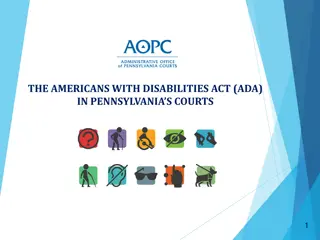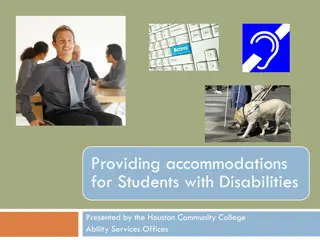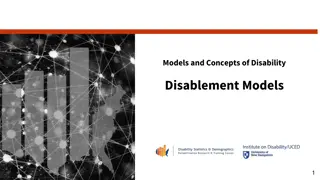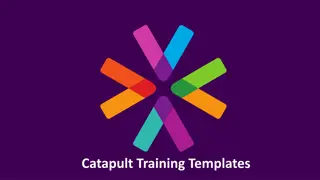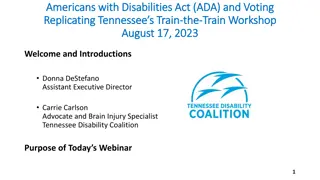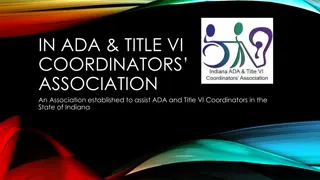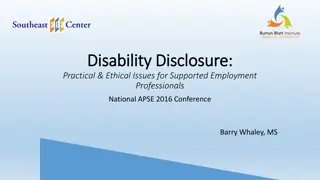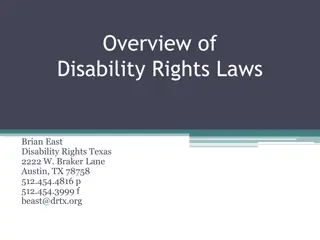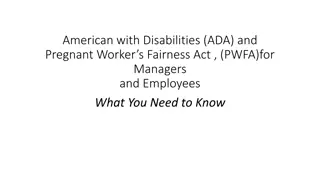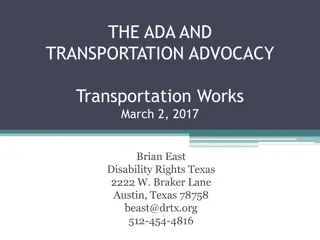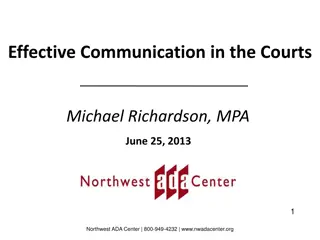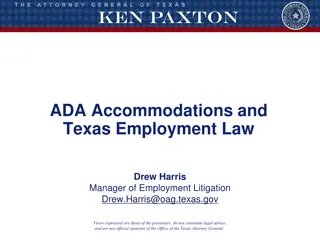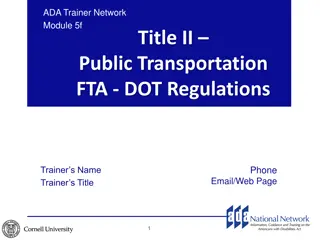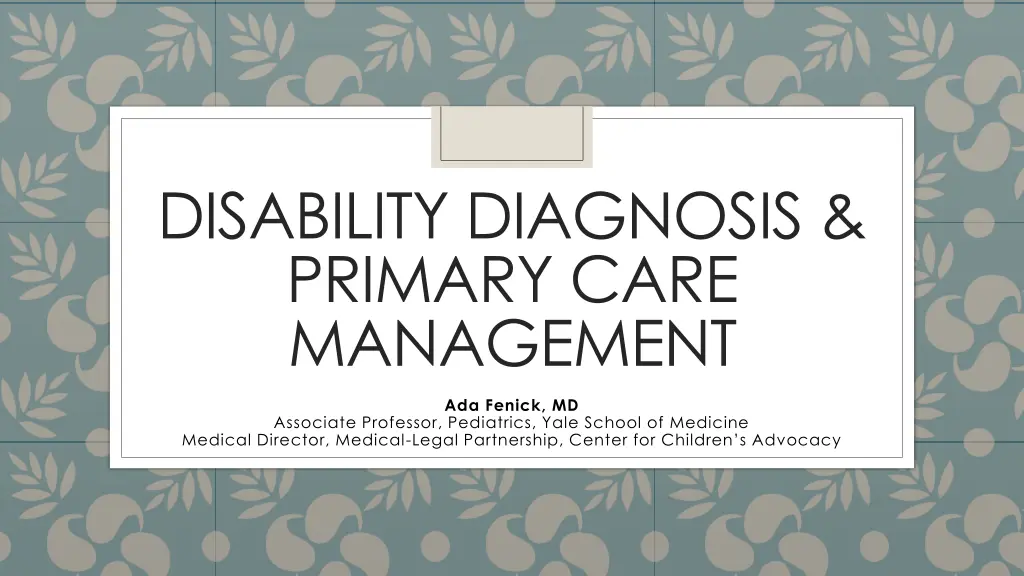
Pediatric Disability Diagnosis & Primary Care Management
Explore pediatricians' approach to disability diagnosis and primary care management through stories of children with different medical and behavioral diagnoses. Understand the common challenges faced by these children and the need for specialized healthcare services to enhance their quality of life.
Download Presentation

Please find below an Image/Link to download the presentation.
The content on the website is provided AS IS for your information and personal use only. It may not be sold, licensed, or shared on other websites without obtaining consent from the author. If you encounter any issues during the download, it is possible that the publisher has removed the file from their server.
You are allowed to download the files provided on this website for personal or commercial use, subject to the condition that they are used lawfully. All files are the property of their respective owners.
The content on the website is provided AS IS for your information and personal use only. It may not be sold, licensed, or shared on other websites without obtaining consent from the author.
E N D
Presentation Transcript
DISABILITY DIAGNOSIS & PRIMARY CARE MANAGEMENT Ada Fenick, MD Associate Professor, Pediatrics, Yale School of Medicine Medical Director, Medical-Legal Partnership, Center for Children s Advocacy
Objectives Understand how pediatricians think about disability for their patients Identify major concepts in pediatric management Medical home Identifying children Care coordination Transition
Objectives Understand how pediatricians think about disability for their patients Identify major concepts in pediatric management Medical home Identifying children Care coordination Transition
Definition of Disability A physical or mental condition that limits a person s movements, senses, or activities.
Disability in the pediatric context Story #1: Joe is a 4-year-old who suffered a devastating neurological event when he was 18 months old. He lives at home but is very limited developmentally - he may smile when mother talks to him, but cannot willfully move his body or safely eat foods. He has a tracheostomy tube to help him breathe, and a gastric tube for foods.
Disability in the pediatric context Story #2: Maria is a 14-year-old with asthma. She takes medication twice per day to manage the asthma, and sees the pediatrician 3 times a year just for medication management. She does great in school, and is thinking of joining the track team but is worried about being able to keep up with the others. She missed 5 days of school last year because of her asthma acting up.
Disability in the pediatric context Story #3: Joseph is an 18-year-old with high functioning autism and Crohn s disease (an inflammatory disorder of the intestines). He takes medications for both of these. His intestines act up often, and on those days he is in a good amount of pain. He is learning to manage his medical issues and while at college will get help from the student office for disabilities. He hopes to get a single room based on his medical diagnoses.
What do these kids have in common? Medical / Behavioral diagnoses Limit their lives to some extent Need more health care than usual With disability, 13% Without disability, 87%
Reframe Children and Youth with Special Health Care Needs Disabled children
Children/Youth with Special Health Care Needs = CYSHCN Special Health Care Needs Children/Youth with ...those who have or are at increased risk for a chronic physical, developmental, behavioral, or emotional condition and who also require health and related services of a type or amount beyond that required by children generally.
Children/Youth with Special Health Care Needs = CYSHCN Special Health Care Needs Children/Youth with Medical diagnoses Long term Requiring one or more of: Use or need of prescription medication Above average use or need of medical, mental health or educational services Functional limitations compared with others of the same age Use or need of specialized therapies (e.g., OT, PT, speech) Treatment or counseling for emotional, behavioral, or developmental problems
Objectives Understand how pediatricians think about disability for their patients Identify major concepts in pediatric management Medical home Identifying children Care coordination Transition
Medical Home The American Academy of Pediatrics (AAP) believes that the medical care of infants, children, and adolescents ideally should be accessible, continuous, comprehensive, family centered, coordinated, compassionate, and culturally effective. It should be delivered or directed by well-trained physicians who provide primary care and help to manage and facilitate essentially all aspects of pediatric care. The physician should be known to the child and family and should be able to develop a partnership of mutual responsibility and trust with them. These characteristics define the medical home. http://pediatrics.aappublications.org/content/110/1/184.full
Identifying CYSHCN Early detection/prevention by screening the population Newborn period: hearing, sickle cell, metabolic problems Early childhood: development, autism School age: behavior, depression
Identifying CYSHCN Patients with needs for Referrals to specialists Referrals to therapists Medications Coordination https://portal.ct.gov/DPH/Family-Health/Children-and-Youth/Children--Youth- with-Special-Health-Care-Needs-and-Connecticuts-Medical-Home-Initiative
Care Coordination Work to ensure that the family can manage medical and non-medical needs of the child within their community. Examples: Regional Care Coordination: paid for by a Title V grant from the Maternal-Child Health Bureau Sporadic grants: e.g., CMS grant for children with medical and mental health needs In-office: provided by providers and nursing staff
Care Coordination The Work Work to ensure that the family can manage medical and non-medical needs of the child within their community. Social Workers MLP Lawyer Child Life Sp. Teaching about management Running screening programs Completing documentation / requests / letters Referring to resources Connecting to community Advocacy The Team Pediatric providers Nurses Examples: Regional Care Coordination: paid for by a Title V grant from the Maternal-Child Health Bureau Sporadic grants: e.g., CMS grant for children with medical and mental health needs In-office: provided by providers and nursing staff
Some elements of success in taking care of medical issues: Talking with providers about your health Knowing what to do when you are sick Taking medications regularly Knowing test results and what they mean Understanding the diagnosis Attending appointments Advocating for yourself and your care Appropriate information gathering
Some elements of success in taking care of medical issues: Understanding why Filling prescriptions Taking medications regularly Taking at right time Identifying possible reactions Reordering prescriptions
Transition planning TRANSITION Children eventually grow up and need to manage their own care if they can. Policy Transfer completion Tracking & Monitoring Transition management Pediatricians typically only care for children (up to age 18-21). Transfer care Determine readiness Planning https://www.gottransition.org/


